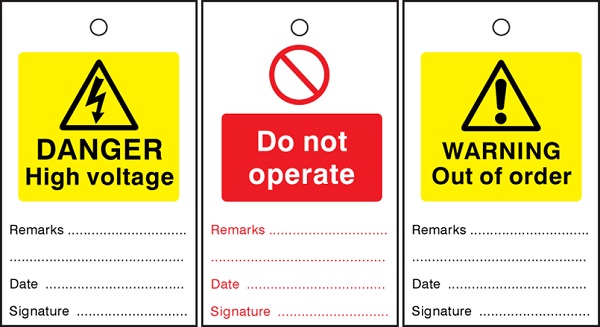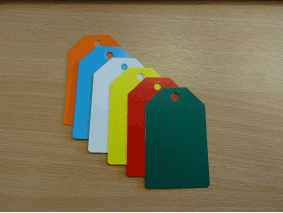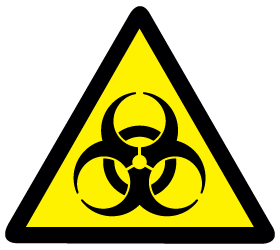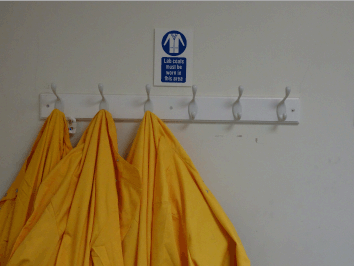Here at Label Source, we sell a variety of electrical tags that can be used to keep people safe around potential electrical hazards. You probably see these tags - or tags just like them - every so often, but do you know how they're supposed to be used? Are you aware of any installations in your workplace that ought to be tagged?

In case you're unsure, here are some examples of when and where our electrical tags should be used:
- If service personnel are repairing, maintaing, or otherwise working on a piece of electrical equipment, the machine in question should be labelled with a tag like this one to prevent anyone else from attempting to use it in the meantime. Many workers have been injured and even killed because somebody started a machine that they were in the process of servicing - don't let your employees suffer the same fate!
- Has one of your machines broken down? You may wish to use an Out of Order tag to ensure that everybody knows the score. If somebody attempts to operate a machine while it is out of order, they may end up causing even more problems, so it's best to label any out-of-action equipment right away.
- We don't just sell electrical tags - we can also supply tags to warn of non-electrical hazards such as asbestos, gas, and poison.
These are merely examples; we recommend visiting our Electrical Tags section to browse our full range. We aim to provide a safety tag for every situation, and our tag collection covers everything from general electrical warnings (e.g. High voltage) to specific instructions (e.g. Do not close valve).
Our ever popular range of plastic tags is in the process of being extended. Six extra colours are being introduced on our more popular sizes, namely purple, grey, dark blue, light green, light brown and pink. Also, there is a new size being added to the range, a 50mm x 80mm version.

All these thermoplastic polymer tags are available in 0.5mm thickness polypropylene. Despite being light in weight, the tags are abrasion, chemical and high impact resistant. Other properties include a resistance to cracking and low moisture absorption, the latter offering resistance to bacterial infection (particularly suitable in food processing or healthcare applications).
These plain, vibrant coloured tags are supplied in several rectangular and circular sizes, in packs of 500 tags. Other sizes can be produced, as well as tags with printed with customer specific information. Contact our sales office by e-mail on sales@labelsource.co.uk or by freephone 0800 3761693 (or +44 1443 842769 from outside UK) for further details or a quotation.
From rollercoaster accidents to fancy dress costumes, it's been a busy week in the world of H&S...
- The health and safety story that's been dominating the headlines this week is the incident that occurred at Alton Towers on Tuesday. According to the Metro newspaper, 4 people were hospitalised - and a further 12 injured - in a collision between two carriages on the 'Smiler' rollercoaster at the Staffordshire theme park. Other sources (including the BBC) have reported that the park's staff did not call 999 until 11 minutes after the crash. The Health and Safety Executive is currently conducting an investigation, and the park remains closed at time of writing.
- A representative for Hugo Boss UK Ltd plead guilty to charges of contravening health and safety regulations on Wednesday, and the company will be sentenced later this month. The charges were brought against Hugo Boss after four-year-old Austen Harrison was crushed by a two-metre-high mirror that was not properly fixed to the wall in the company's Bicester Village store in 2013; the boy suffered severe brain damage as a result of the accident, and eventually died after being taken off life support.
- Claudia Winkleman has successfully forced a number of big-name retailers to tighten their health and safety standards with regards to children's fancy dress costumes. Winkleman's eight-year-old daughter suffered serious burns after her Halloween costume caught fire last October; according to the Express, the Strictly Come Dancing host was "incensed to discover that the costumes only have to be tested to the same level as toys". Since the accident, Winkleman has been campaigning for stricter regulations on children's fancy dress products, and it seems that her hard work has been rewarded - several large British supermarkets (including Sainsbury's, Tesco, and Asda) will now ensure that all children's costumes meet the same health and safety standards as nightwear products.
- The UK's first privately-funded NHS hospital was also under scrutiny for fire safety failings this week. The Cumberland Infirmary (located in Carlisle) was criticised by Cumbrian's Fire Brigades Union who called the hospital a "major" safety risk and highlighted the inadequacy of the building's fire proofing measures, which - according to the Independent - "did not meet the required protection standard to allow for save [sic] evacuation". The fire fighters have urged the hospital's stakeholders to re-assess the fire safety procedures and materials that have been put into place, warning that "vulnerable patients" could be in particular danger if changes are not made.
- Technology giants Apple found themselves at the centre of yet another fire safety story this week when their Beats Pill XL speakers were recalled on the ground of being a potential fire hazard. The product was launched back in 2013, but - as thefourohfive.com pointed out - "it remains Apple's responsibility to identify, alter or discontinue fault goods being sold under their jurisdiction". The company's official statement is as follows: "Apple has determined that, in rare cases, the battery in the Beats Pill XL may overheat and pose a fire safety risk".
- We end this week's round-up with yet another example of somebody blaming health and safety for something that has absolutely nothing to do with health and safety. Of course, we're used to ridiculous "elf 'n' safety" fiascos in Britain, but this particular story actually comes to us from the USA: it seems that the Louisiana Girl Scouts are refusing to accept transgender members due to - you guessed it - "health and safety" concerns. The HSE haven't covered this story on their brilliant Myth Busters blog, but if they did, we imagine they'd advise the Louisiana Girl Scouts to stop blaming H&S for their own personal views on who should or shouldn't be allowed to join!
Follow @LabelSourceUK on Twitter for more H&S news and discussion!
A safe working environment relies on a multitude of different factors, but perhaps the most important of all is information. As an employer, it is your responsibility to ensure that your staff are up to speed with all of the health and safety regulations that affect their work.
This, of course, means that you have to provide health and safety training for everyone who joins your workforce; however, bear in mind that a single training session on initiation day may not be enough to fulfil your obligations as company owner. People generally won't remember everything you tell them on their first day at work, and that's why you have to ensure that your employees are frequently reminded of the relevant safety information.
One way to do this is with health and safety posters. Placing these brightly-coloured notices around your workplace is a great way to keep safety at the front of everybody's mind, and the information printed on the posters may just save somebody's life one day.
Here are some of the workplace safety posters available from Label Source:
Office Safety Poster
This poster features several pieces of general guidance that are applicable to most office environments.
Manual Handling Poster
If your workers are frequently required to lift heavy loads, this poster will help them to ensure that they stay safe while doing so.
Fire Safety Poster
You never know when a fire might break out. This poster will inform your employees of what to do in the case of such an emergency.
Workplace First Aid Guide
Most workplace safety posters aim to prevent accidents. This one gives advice on what to do if prevention fails and a life-or-death situation arises.
These are just a few of the safety posters available from Label Source's website - click here to see our full range.
Many companies operate with the risk to health from exposure at work to biological agents. These bacteria, viruses, parasites or fungi can cause biological infection, ranging from mild discomfort to acute or even chronic health issues. Therefore, it is imperative that such biohazard risks are identified, fully assessed and controlled.

Much of the legislation covering biological safety stems from the Control of Substances Hazardous to Health (COSHH) 2002 and The Management of Health and Safety at Work Regulations 1999, and lays the foundation for effective measures to minimise or eliminate biological risks to human health.
Many health and safety measures to prevent biological infections can include controlling the following;
- Personal hygiene. To encourage regular washing of hands, and where practical supplementing with the use of hand sanitisers.
- First aid. All open wounds such as cuts, scratches or grazes should be washed and treated, before being covered with protective, waterproof dressings. Eye wash or emergency shower facilities.
- Rest areas. All meal breaks should be taken remotely away from the work area.
- Cross contamination. Avoid the transfer of infection from hands by contact to eye, mouth or nose.
- Protective clothing. Appropriate personal protective equipment (PPE) should be worn to eyes (visors face shields or goggles), breathing (masks or respirators), ears (ear protectors), hands (gloves or gauntlets), body (aprons, gowns, lab coats or overalls), and feet (overboots).
- Waste disposal. Contaminated waste, substances or clothing should be disposed of safely.
- Housekeeping. Work equipment and work surfaces should be cleaned and decontaminated, which may include sterilizing or autoclaving in some sectors.
- Building maintenance. Air conditioning should prevent build up or circulation of dusts or liquids, water supply should be checked for micro-organism growth (legionella), and adequate ventilation
- Pest control. To prevent bites and infection from waste from pests, insects or animals.
- Protection from injury by sharps. To prevent the piercing of skin from needles or broken glass.

It is the employers’ responsibility to identify any of the risks and accompanying preventative actions necessary as outlined above. At Label Source we supply a comprehensive range of health and safety signs to promote good practice and endorse sound operating procedures. These include biological hazard warning signs, labels and tapes; mandatory safety signs including personal protection ranges; prohibition safety signs; first aid signs; and waste management signs.
Our customers include:
- Clinical or biomedical scientific research laboratories.
- Healthcare, including hospitals, health centres, dental surgeries, social care, chiropodist or acupuncture practices, and associated services, such as porters, cleaners and laundry workers.
- Animal welfare, such as veterinary practices, zoos, farms, kennels, catteries and stables.
- Social services including, social workers, care workers and custodial services (police or prison services).
- Horticultural services such as groundsmen, gardeners and park keepers.
- Waste services including refuse collectors, sewerage workers, ditch cleaners and sludge removers.
- Other services including undertakers, grave diggers, poultry processors, abattoirs, butchers, tattooists, hairdressers and beauticians.
For more information on the product ranges available on biological hazards please visit our website www.labelsource.co.uk or contact us by e-mail on sales@labelsource.co.uk for further information.